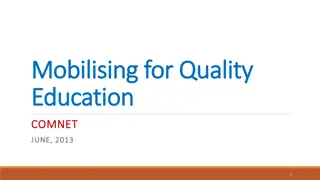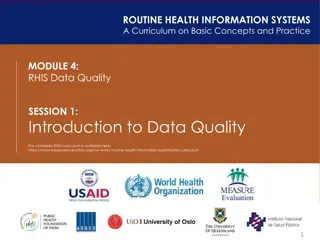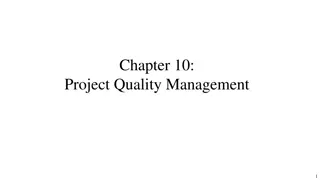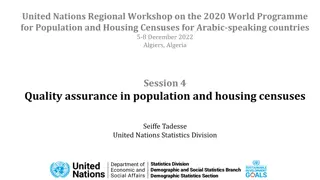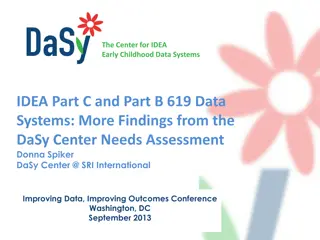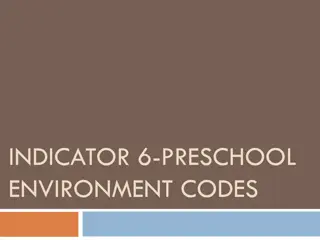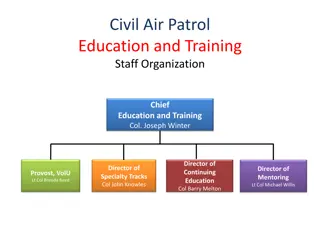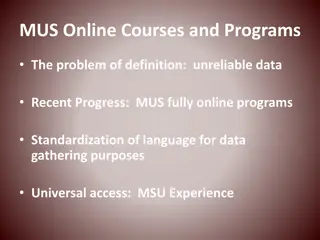Importance of High-Quality Data in Education Programs
Understanding the significance of high-quality data is crucial for improving outcomes in education programs. This post-conference meeting emphasizes the importance of data governance, processes, and working principles for obtaining accurate and timely data. Achieving high-quality data is essential for reporting state performance, evaluating IDEA requirements, and informing decision-making at both state and local levels.
Download Presentation

Please find below an Image/Link to download the presentation.
The content on the website is provided AS IS for your information and personal use only. It may not be sold, licensed, or shared on other websites without obtaining consent from the author. Download presentation by click this link. If you encounter any issues during the download, it is possible that the publisher has removed the file from their server.
E N D
Presentation Transcript
Data Quality Counts! PACIFIC ISLAND/CARIBBEAN ISLAND/BUREAU OF INDIAN EDUCATION 2018 IMPROVING DATA, IMPROVING OUTCOMES POST-CONFERENCE MEETING Arlington, VA Tony Ruggiero, IDC August 16, 2018
Participant Outcomes By the end of the session, meeting participants will Understand the importance of high-quality data Be familiar with the risks of poor data quality Understand the importance of documenting the data collection and cleaning process to obtain high-quality data Learn about other jurisdictions processes for monitoring data quality and the supports provided to both state and local agency staff 1
The Connection Between Data Governance and High-Quality Data Data Governance is the overarching collection of practices and processes which help to ensure the formal management of data. Processes Business Rules 2
What Does This Have to Do With Data Quality? Poorly managed IDEA data collection, validation, analysis, and submission processes can lead to poor data quality. 3
Working Principles of High-Quality IDEA Data Timely Accurate Complete Secure Accessible Usable https://ideadata.org/sites/default/files/media/docum ents/2017-09/idc-hqd_source.pdf 4
The Importance of High-Quality Data High-quality data have become increasingly important to state agencies and the Office of Special Education Programs (OSEP) for: Reporting State Performance Plan/Annual Performance Report (SPP/APR) Evaluates a state s efforts to implement the requirements of IDEA Describes how the state will improve implementation Informs the public on the performance of each local education agency (LEA) or local early intervention service (EIS) program in the state on targets in the SPP/APR Informs the Secretary and the public on the performance of the state under the SPP/APR 5
The Importance of High-Quality Data (cont.) States need high-quality data to go beyond reporting. Shift at OSEP from monitoring to Results Driven Accountability (RDA) State Systemic Improvement Plan (SSIP) Research and Evaluation 6
The Importance of High-Quality Data (cont.) IDEA data reported to OSEP are critical for Developing and improving policy Improving programs Increasing children s achievement 7
The Importance of High-Quality Data (cont.) Example IDEA Part C coordinators and data managers can use Timeliness data to Work on solutions to increase the number of children who receive services in a timely manner Investigate the relationship between receiving services in a timely manner and child outcomes Identify professional development opportunities for staff to ensure infants and toddlers are receiving services in a timely manner 8
The Importance of High-Quality Data (cont.) Example IDEA Part B state program directors and data managers can use least restrictive environment (LRE) data to Work on solutions to increase the number of students in more inclusive education settings Investigate the relationship between education environments and student outcomes Review and adjust funding models to reduce fiscal incentives that might reduce access to the LRE 9
Data As an Asset The need for high-quality data has been universally identified and can be: An organizational, program, or policy asset that Serves as a reliable source for data driven decision making Serves as a reliable source that can help secure additional resources 10
The Risks of Poor Data Quality Poor data quality can Reduce customer satisfaction Breed organizational mistrust Make it difficult to start efforts that lead to improvement Support bad decision making Inhibit good data-driven decisionmaking (e.g., allow stakeholders to make policy decisions based on erroneous data) 11
Getting to High-Quality Data There are points in the data collection and use process to increase the probability of getting to high-quality data. 1. Prevent 2. Detect and Repair 3. After the Fact 12
Data Collection Process (cont.) Collaboration is key. How does the state support LEA or local EIS programs What supports are in place How does the state deliver supports Collaboration is important because it feeds into data use for both state and LEA or local programs benefits for both 14
Data Quality and Integrity IDEA Data Center Part B Data System Framework Quality Indicator DG5: State staff or authorized representatives implement monitoring procedures and technical assistance to ensure consistent application of data quality and integrity policies. 15
Data Quality and Integrity (cont.) Elements of Quality a. State staff or authorized representatives communicate regularly to system users (e.g., local staff) about data quality procedures. b. State staff or authorized representatives regularly monitor the implementation of the quality procedures for data. c. State staff or authorized representatives have a data collection and quality orientation training for data managers at the state and local levels. 16
Data Quality and Integrity (cont.) Elements of Quality (cont.) d. State staff or authorized representatives create and maintain standardized training materials regarding policies, procedures, and responsibilities for data collection and quality operations, and update training materials as needed. e. State staff or authorized representatives ensure adherence to data quality procedures when data are exchanged or transferred. f. The data collection and quality procedures for the state s data system are reviewed and revised periodically as new management needs arise. 17
Data Quality and Integrity (cont.) Elements of Quality (cont.) g. State staff or representatives support state/local programs and agencies to implement policies and procedures in a manner consistent with state policies and procedures, while allowing for local variation in context. h. State staff have a system or method for ensuring data proficiency for the state data manager. i. State staff have a system or method for supporting data proficiency for local data managers. 18
Data Quality and Integrity (cont.) Elements of Quality (cont.) j. State staff or authorized representatives provide multiple resources (e.g., procedural guides, webinars, help desk) to facilitate and support local staff with implementation of data collection and quality procedures. k. State staff or authorized representatives provide guidance and support for the assessment of state and local capacity to implement quality procedures. l. State staff or authorized representatives provide guidance and support in response to staff capacity needs at the state and local levels. 19
Data Quality and Integrity (cont.) Guiding Questions What guidance (e.g., Q and A, knowledge base, guidance documents, data tips, etc.) does the state publish on data quality procedures? How does the state communicate data quality procedures to system users (e.g., website, distribute to LEAs, schools, local programs or providers)? What is the process for LEAs, schools, local programs, or providers to report and resolve known data quality issues? Is this process included in written data quality procedures? 20
Data Quality and Integrity (cont.) Guiding Questions (cont.) What is the established data quality review period for Part C and Part B data collections? How does the state confirm that the data validations are working as intended? How does the state run data quality analysis on final data to determine potential data quality issues? 21
Data Quality and Integrity (cont.) Guiding Questions (cont.) Does the state provide any training on data quality for LEA or local program staff? What kind of training is provided? How often? Who (role) at the LEA or local program participates in data collection and quality orientation training? 22
Data Quality and Integrity (cont.) Guiding Questions (cont.) What do the standard training materials include? Where are they located? Who (role) has access to the training materials? How often are they updated? Who (role) is responsible for updating the training materials? Who (role) is involved in the development and review of content? How are Part C or Part B State staff involved? How is internal and external stakeholder and participant feedback used to improve the materials? 23
Data Quality and Integrity (cont.) Discussion Questions 1. What data quality training is provided to new state data managers? a. What is included in the training? b. How is it delivered? c. How often? 2. What follow-up coaching occurs? 3. How does the state address any existing capacity issues to meet the demand for training and coaching? 24
Data Quality and Integrity (cont.) Discussion Questions (cont.) 4. How does the state provide training to LEAs, schools, local programs, or providers to address data quality issues? 5. As part of the training, how are the roles and responsibilities clearly defined and communicated regarding implementation of data quality procedures? 25
Data Quality and Integrity (cont.) Discussion Questions (cont.) 6. What is the process for monitoring the data quality of LEAs, schools, local programs, or providers data? a. How often does the LEAs, schools, local programs, or providers monitoring occur? 26
Barriers to Collecting High-Quality Data (cont.) There are several potential barriers to collecting high-quality data Data System Buy-in Resources Content and Assessment Knowledge 28
Lets Review Understand the importance of high-quality data Be familiar with the risks of poor data quality Understand the importance of documenting the data collection and cleaning process to obtain high-quality data Learn about other jurisdictions processes for monitoring data quality and the supports provided to both state and local agency staff 29
Contact Us Tony Ruggiero tony.ruggiero@aemcorp.com 30
For More Information Visit the IDC website http://ideadata.org/ Follow us on Twitter https://twitter.com/ideadatacenter Follow us on LinkedIn http://www.linkedin.com/company/idea -data-center 31
The contents of this presentation were developed under a grant from the U.S. Department of Education, #H373Y130002. However, the contents do not necessarily represent the policy of the U.S. Department of Education, and you should not assume endorsement by the federal government. Project Officers: Richelle Davis and Meredith Miceli 32


